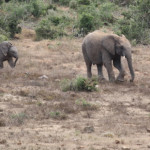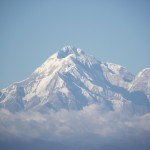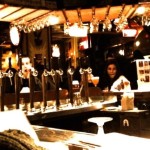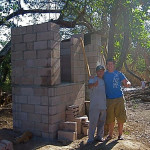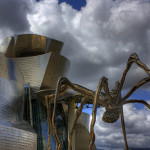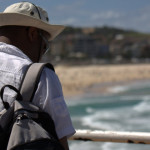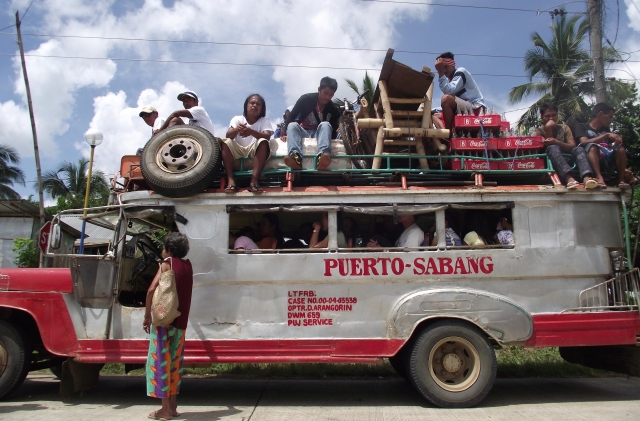
My first close-call in the Philippines was when I flew into Manila in October of 2010 the very same day as super typhoon Megi, one of the most intense tropical cyclones ever recorded. I’d checked the news daily before catching my flight, and didn’t see anything at all about it. I guess CNN was too busy covering the latest sex scandal or celebrity wardrobe mishap or something else of extreme importance and global significance. I checked into a room, promptly took a nap due to sheer exhaustion from the long flight over the Pacific; then got up late in the afternoon, pulled out my laptop and got online to see the headline: “Super Typhoon Hitting Philippines.” Huh?!
Fortunately for the more than 11 million people who live in the Manila metropolitan area, it hit further north on the island of Luzon (where unfortunately it caused major carnage, before moving on to cause catastrophic flooding in Taiwan). I spent the night listening to the heavy wind and rains of the outer bands, feeling a mix of both relief, and guilt, that the worst of it was hitting elsewhere.
Puerto Princesa, Palawan
Two days later I flew to Puerto Princesa, Palawan. Palawan was my real destination, where I would spend most of my 3-week trip to the Philippines. I explored the pleasant, mellow little city of Puerto Princesa for a few days; before hopping in a “jeepney” along with my trusty backpack (the jeepney is the most popular form of mass transit in the Philippines, which were formerly U.S. military vehicles, left over from World War II). We went a few hours up and over the thin part of Palawan island to Sabang on the other side, which is the closest little town (if you could call it that, more like a smattering of huts) to the famous nearby underground river, recently voted as one of the seven natural wonders of the world.
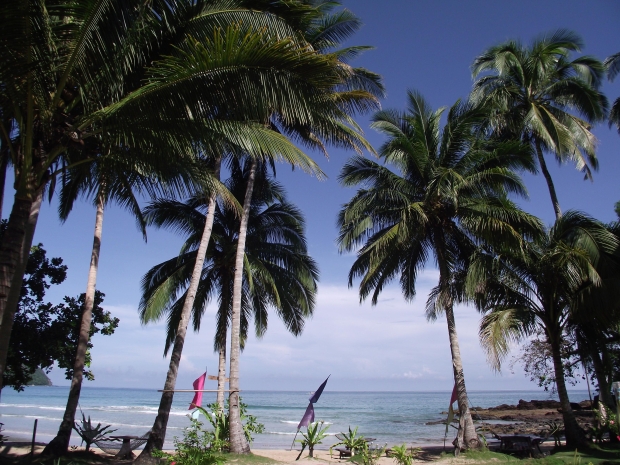
Sabang Palawan
I got my own little bamboo hut for about $7, relaxed back in a hammock, played with their pet monkey, enjoyed the perfect nearby beach complete with swaying palm trees; and the next day visited the underground river. This involved a 3-mile hike through the jungle, where I saw a huge monitor lizard along the way, as well as monkeys jumping from tree to tree. I toured the impressive underground river, then did the 3-mile hike back to my hut.
The El Nido boat trip plan
At dinner that night at the resort’s (again, if you could call it that!) little restaurant I met a couple, Pete from Scotland and Claudia from Germany. They were planning to head to the town of El Nido next on the northern tip of the island, which is really the jewel of Palawan and was also my next destination. I was planning to catch a jeepney and/or a bus up there the next day, as it was an all day journey for which there was no direct transportation. They were planning to take a boat up the coast, which the owner of the bamboo huts was going to arrange for them. They said there was room for one more if I wanted to come along, since that would bring the price down for all of us. I said sure, and we arranged to meet up in the morning.
Next morning, all packed up and ready to go, we met on the beach nearby where there was indeed a boat waiting (if you could call it that!). It was a typical Philippines “bangka”, which in its simplest form looks sort of like a canoe with two outriggers sticking out on either side for stability. This one, however, looked more or less like it had been recently constructed from odd pieces of scrap found at a trash heap. Oh yeah, and it was missing an engine. A few minutes later, two men showed up carrying the engine. “Fixed yesterday!” one of them said.
Pete remarked jokingly, “I see, so this is the test run then eh?”
Three young boys also showed up around then. After securing the engine in its proper place, the two men walked off, one of them saying, “Have nice trip!”
The three young boys then climbed into the boat, and one of them waved at us to climb in.
Confidence was not being inspired here. It was a three-hour boat ride, and there was only one outpost of civilization along the way, another tiny town. Other than that, we would be watching pure jungle roll by as we putted along.
They started up the engine and the three of us climbed in and took our “seats”. This involved more or less occupying the sliver of space left between our assorted backpacks. One of the boys hopped out and pushed the boat into the water. Off we went, putting out into the wild blue yonder.
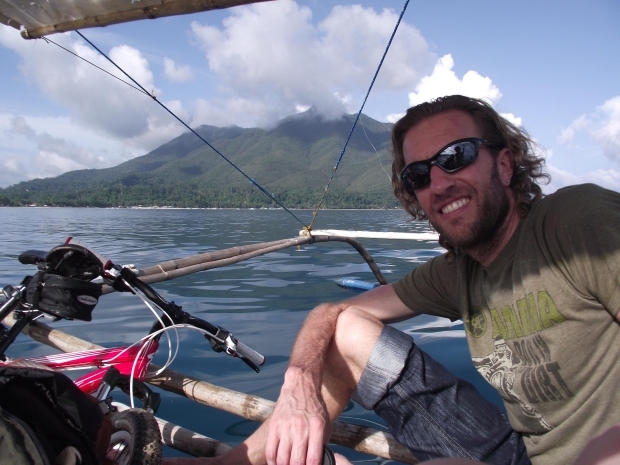
The author out at sea
Engine trouble
About five minute later, the engine died. They started it back up, and we continued putting along, the waving palm trees on the beach ever so slowly getting a bit farther away, as the sun began to rise into the early morning sky.
Another five minutes, and the engine died again. It took a little longer for them to get it going this time, but they did. Three minutes later, and it died again. I wish I’d kept track of exactly how many times the engine died over the course of about twenty minutes. Somewhere in the 7-10 range. A few more times, and Pete, Claudia and I voiced to each other what we’d all been thinking.
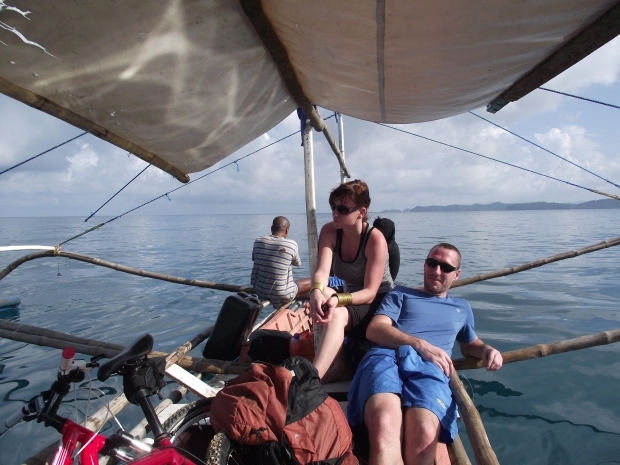
Pete and Claudia on the boat
“So what do you think, should we call it quits and ask them to turn back?” I said. ” If that engine gives out entirely an hour from now, we are seriously screwed.”
It didn’t take too much debate. Pete spoke up to the boys as they were messing around with the engine, trying to get it going again.
“Let’s go back, engine no good.”
We were a bit surprised at how readily they all mutually agreed. It appeared they weren’t quite so keen on this adventure either. Probably they had been paid a pittance to take us up north (while the owner of the huts kept the rest), maybe even never having done the whole trip before. At any rate, they got the engine fired up again, we turned the boat around and started heading back towards the shore, which was a few miles away by now.
Paddle back to dry land
A couple of minutes later the engine died again, this time accompanied by a sharp popping sound. They all went back to work trying to get it started up again but to no avail. It was dead, toast, history. The three boys looked at each other with the apparent expression of, “So now what do we do?” Then one of them rummaged around at the bottom of the boat, and produced a single, solitary oar, if you could call it that. More like a piece of scrap wood that must have come from the same heap from which the boat itself had been pieced together.
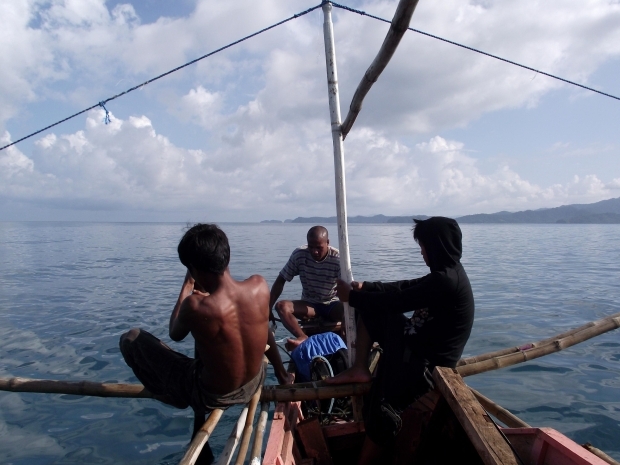
Expert boating crew
The oar was inserted in the calm, deep blue waters, swirled around a bit, and slowly, ever so slowly, we began moving in the general direction of the shoreline. It’s a damn good thing there was no current, no wind, no waves, because even as it was it took us a good hour-and-a-half or more to retrace our steps.
We were all, most definitely, incredibly relieved to finally feel our feet on firm sand again. I headed back towards the center of the village, where I was more than willing to cram myself into a packed, slow-moving jeepney, and endure the day-long journey on dry land.

